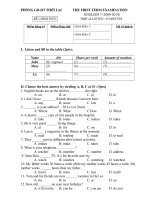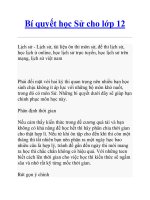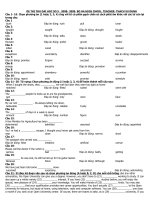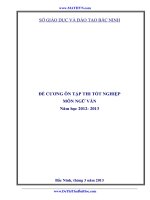Tải Đề ôn thi học kì 2 lớp 5 môn tiếng Anh có file nghe + đáp án (Số 4) - Đề thi học kì 2 lớp 5 môn tiếng Anh
Bạn đang xem bản rút gọn của tài liệu. Xem và tải ngay bản đầy đủ của tài liệu tại đây (4.41 MB, 37 trang )
<span class='text_page_counter'>(1)</span><div class='page_container' data-page=1>
<b>Full name: ...</b>
<b>Class: ...</b>
<b>ENGLISH LANGUAGE TEST</b>
<b>Time: 45 minutes</b>
<b>I. LISTENING</b>
</div>
<span class='text_page_counter'>(2)</span><div class='page_container' data-page=2></div>
<span class='text_page_counter'>(3)</span><div class='page_container' data-page=3></div>
<span class='text_page_counter'>(4)</span><div class='page_container' data-page=4></div>
<span class='text_page_counter'>(5)</span><div class='page_container' data-page=5>
<b>Task 2. Listen and tick A, B or C. There is</b>
<b>one example.</b>
<i>Example:</i>
A. It’s in Ninh Binh Province.
B. It’s very big.
C. It’s not very far.
1. A. Yes,
I’d like it.
B. Yes, I
like it.
</div>
<span class='text_page_counter'>(6)</span><div class='page_container' data-page=6>
2. A. West
Lake
B. Thong
Nhat
Stadium
C. Tran
Quoc
Pagoda
3. A. I
visited
Huong
Pagoda.
B. I am
going to
visit Huong
Pagoda.
</div>
<span class='text_page_counter'>(7)</span><div class='page_container' data-page=7>
4. A. It’s in
Quang
Ninh
Province.
B. It’s
more
beautiful
than I
expected.
C. It’s a
bay.
5. A. It’s in
Ha Long
Bay.
B. It’s
quite small.
C. It’s in
the centre
of Ha Noi.
<b>Task 3. Listen and tick the correct</b>
<b>pictures. There is one example. </b>
<i>Example:</i>
</div>
<span class='text_page_counter'>(8)</span><div class='page_container' data-page=8></div>
<span class='text_page_counter'>(9)</span><div class='page_container' data-page=9></div>
<span class='text_page_counter'>(10)</span><div class='page_container' data-page=10></div>
<span class='text_page_counter'>(11)</span><div class='page_container' data-page=11></div>
<span class='text_page_counter'>(12)</span><div class='page_container' data-page=12></div>
<span class='text_page_counter'>(13)</span><div class='page_container' data-page=13></div>
<span class='text_page_counter'>(14)</span><div class='page_container' data-page=14></div>
<span class='text_page_counter'>(15)</span><div class='page_container' data-page=15></div>
<span class='text_page_counter'>(16)</span><div class='page_container' data-page=16></div>
<span class='text_page_counter'>(17)</span><div class='page_container' data-page=17></div>
<span class='text_page_counter'>(18)</span><div class='page_container' data-page=18></div>
<span class='text_page_counter'>(19)</span><div class='page_container' data-page=19>
<b>Task 4. Listen and write R for Right or W for Wrong. There is one example (0).</b>
0. Trang is from Hanoi. ____R___
1. There are traffic jams all day in Ha Noi. _________
2. Trang doesn’t want to live in Ha Noi. _________
3. Her grandparents live a quiet life in Hoa Binh. _________
4. Last summer, Trang went to a lake near her grandparents’ house. _________
5. They swam in the lake and visited an island. _________
<b>II. READING</b>
</div>
<span class='text_page_counter'>(20)</span><div class='page_container' data-page=20></div>
<span class='text_page_counter'>(21)</span><div class='page_container' data-page=21></div>
<span class='text_page_counter'>(22)</span><div class='page_container' data-page=22>
<i>Example: They work in a company or in a factory.</i> workers
1. He loves children and helps them to learn. _________
2. He designs houses and buildings. _________
3. He/She works in a field or in a farrm. _________
4. Their job is dancing. _________
5. He can keep our town or city safe. _________
<b>Task 2. Read and tick True or False.</b>
<b>There is one example (0).</b>
In Britain and Australia, many people like
eating bacon sandwiches. They are made
from bread and cooked bacon, a kind of
fried meat. People enjoy eating bacon
sandwiches with butter and some sauce.
Bacon sandwiches are favourite food and served all day throughout the countries.
In Viet Nam, <i>Pho</i> is a popular food. People love eating <i>Pho</i>. It is made of rice noodles and beef or chicken
broth. This is a kind of soup with a good taste. People enjoy eating <i>Pho </i>at anytime of the day. It is a
delicious traditional dish.
<b>True False</b>
0. Many people in Britain and Australia like eating bacon sandwiches.
1. Bacon sandwiches are made from bread and cooked bacon.
</div>
<span class='text_page_counter'>(23)</span><div class='page_container' data-page=23>
3. Bacon sandwiches are served all day in both countries.
4. Vietnamese Pho is made from beef or chicken soup.
5. People love eating Pho because it is a delicious traditional dish.
<b>Task 3. Read and number the sentences in the correct order. The conversation begins with 0.</b>
A <i><b>Lan:</b></i> Tokyo? What do you think of the capital of Japan?
B <i><b>Nick:</b></i> I went to Tokyo.
C <i><b>Lan</b></i>: Oh, really? Which city is more expensive, Tokyo or Ha Noi?
D <i><b>Nick:</b></i> It’s a beautiful city, but it’s more exciting than Ha Noi.
0. E <i><b>Lan: </b></i>Where did you go last summer, Nick?
F <i><b>Nick: </b></i>I think Tokyo is. But things there are better than things in Ha Noi.
<b>Task 4. Read and fill each gap with one word from the box. Write the word next to the number. There</b>
<b>is one word that you do not need. There is one example (0).</b>
</div>
<span class='text_page_counter'>(24)</span><div class='page_container' data-page=24></div>
<span class='text_page_counter'>(25)</span><div class='page_container' data-page=25></div>
<span class='text_page_counter'>(26)</span><div class='page_container' data-page=26></div>
<span class='text_page_counter'>(27)</span><div class='page_container' data-page=27>
grandparents pharmacy motorbikes
Phong lived with his parents in a (0) village in An Giang Province. This year, his family moved to Can Tho.
Now they live in a (1) ____________ in a busy street. There’s a (2) ____________ and a bookshop
opposite his house. There are a lot of (3) ____________, cars and buses in the street. Phong’s school is
at the end of the street, so he can (4) ____________ there in ten minutes. There’s a park next to his
school. In his free time, Phong often go (5) ____________ with his friends there. Phong thinks that life in
the city is more exciting than in the village.
<b>III. WRITING</b>
<b>Task 1. Look at the pictures and the example. Read the story and write the word(s) for each gap. There</b>
<b>is one example (0).</b>
</div>
<span class='text_page_counter'>(28)</span><div class='page_container' data-page=28></div>
<span class='text_page_counter'>(29)</span><div class='page_container' data-page=29></div>
<span class='text_page_counter'>(30)</span><div class='page_container' data-page=30></div>
<span class='text_page_counter'>(31)</span><div class='page_container' data-page=31>
We live in Binh Duong Province. It was (0) sunny last Sunday. My class visited Ho Chi minh City. We had a
city tour by (1) _________. In the morning, we visited some places such as the City Theatre, the zoo and
(2) _________. In the afternoon, we came to see (3) _________. It was more beautiful than I expected.
In the evening, we came back home by (4) _________. We had a good time there. I like Ho Chi Minh
City because it’s beautiful, and life there is more exciting than in my (5) ________.
<b>Task 2. Order the words. There is one example.</b>
<i>Example:</i> watch/ in/ I/ my/ time/ free/ TV
I watch TV in my free time.
1. often/ what/ in/ free/ do/ you/ time/ do/ your
_____________________________________________?
2. a/ my/ twice/ swimming/ week/ goes/ sister
_____________________________________________.
3. do/ in/ karate/ my/ I/ time/ free/ often
_____________________________________________.
4. often/ go/ you/ how/ English/ the/ club/ to/ do
_____________________________________________?
5. one/ fishing/ brother’s/ of/ my/ is/ hobbies
_____________________________________________.
<b>Task 3. Write a short letter to your friend and show her the way to get to you house. There is one</b>
<b>example (0).</b>
You can write about:
0. How do you feel when you know your friend is going to visit you?
1. What’s your address?
2. How long does it take to get to your house?
3. What means of transport can your friend take to get to your house?
4. From the post office, how can your friend get to your house?
5. Does your friend call you when she/he is near your house?
To: Anne Brown
215 Green Street, London
England
Dear Anne,
I’m very (0) happy you’re going to visit me in Viet Nam.
My address is (1) _______________________________________.
</div>
<span class='text_page_counter'>(32)</span><div class='page_container' data-page=32>
office. From there you can (4) ___________________________.
Please (5) _________________________ when you are near my house.
See you soon.
Love,
Minh
<b>IV. SPEAKING</b>
<b>Task 1. Interviewing</b>
<b>Task</b>
<b>1</b> <b>Teacher does this:</b> <b>Teacher says this:</b> <b>Minimumresponse expected</b>
<b>from Student:</b>
<b>Back-up questions:</b>
Greets and takes
part in the
conversation.
Hello, my name’s …
And you are …
Now, answer my
questions.
Student answers the
questions.
What’s your name?
What’s your address? Is it … ?
What does your
father do? What does
your mother do?
Is he …? Is she …?
What do you do in
your free time?
Do you …?
What subjects do you
have at school?
Do you have
Maths/English/Art …?
What would you like
to be in the future?
Would you like to be
…?
</div>
<span class='text_page_counter'>(33)</span><div class='page_container' data-page=33></div>
<span class='text_page_counter'>(34)</span><div class='page_container' data-page=34></div>
<span class='text_page_counter'>(35)</span><div class='page_container' data-page=35>
<b>Tas</b>
<b>k 2</b>
<b>Teacher does</b>
<b>this:</b>
<b>Teacher says this:</b> <b>Minimum</b>
<b>response</b>
<b>expected from</b>
<b>Student:</b>
<b>Back-up questions:</b>
Shows a box
full of cards,
one by one.
Takes part in
the
conversation.
Look. There are some
cards in this box.
Now, count them.
How many cards are
there in the box?
Student
responds to
instructions and
questions.
Let’s count.
Show me card number
2. What is it? Put it on
the table.
Where’s card number 2? Is it a
bar of chocolate? Yes?/No? Is
it a cake? What cake is it?
What are they in card
number 5? How many
are there?
Are they…? Count them,
please.
Now, place card
number 1 next to card
number 6. What
would you like to be
in the future?
Look at card number 1.
What’s her job? Look at card
number 6. What’s his job?
What job would you like to be
in the future?
Now show me card
number 4 again. What
do you see? Shoud
you ride your bike too
fast?
Is it a bike?
Why shouldn’t you ride your
bike too fast?
Look at cards number
3 and 5 again. Why
shouldn’t you eat too
much chocolate or
sausages?
What do see in card number 3?
Do you like chocolate?
How many sausages do you
eat every day? Why shouldn’t
you eat too many sausages?
<b>Task 3. Describing a picture</b>
</div>
<span class='text_page_counter'>(36)</span><div class='page_container' data-page=36>
<b>Tas</b>
<b>k 3</b>
<b>Teacher does</b>
<b>this:</b>
<b>Teacher says this:</b> <b>Minimum</b>
<b>response expected</b>
<b>from Student:</b>
<b>Back-up questions:</b>
Shows the card.
Takes part in the
conversation.
Now you look at the
picture. Then
describe it. OK?
Student describes
the picture.
What do you see in the
picture?
What do you think of life
here?
Imagine you are here.
What would you like to
do? Why/Why not?
The end
--Đáp án
<b>I. LISTENING</b>
<b>Task</b> <b>1.</b>
<b>Listen and</b>
<b>match.</b>
<b>There is one</b>
<b>example (0).</b>
<b>Key: 1. F 2. A</b>
3. B 4. D 5. C
<b>Task</b> <b>2.</b>
<b>Listen and</b>
<b>tick A, B or</b>
<b>C. There is</b>
<b>one</b>
<b>example.</b>
<b>Key: 1. C 2.</b>
A 3. A 4. B 5.
C
<b>Task</b> <b>3.</b>
<b>Listen and</b>
<b>tick the</b>
</div>
<span class='text_page_counter'>(37)</span><div class='page_container' data-page=37>
<b>Task 4. Listen and write R for Right or W for Wrong. There is one example (0).</b>
<b>Key: 1.W 2.W 3.R 4.R 5.W</b>
<b>II. READING</b>
<b>Task 1. Look and write the correct words. There is one example.</b>
<b>Key: 1. teacher 2. architect 3. farmer 4. dancers 5. policeman</b>
<b>Task 2. Read and tick True or False.</b>
<b>There is one example (0).</b>
<b>Key: 1. True 2. False 3. True 4. False 5.</b>
True
<b>Task 3. Read and number the sentences</b>
<b>in the correct order. The conversation</b>
<b>begins with 0.</b>
<b>Key: 1. B 2. A 3. D 4. C 5. F</b>
<b>Task 4. Read and fill each gap with one word from the box. Write the word next to the number. There</b>
<b>is one word that you do not need. There is one example (0).</b>
<b>Key: 1. house 2. pharmacy 3. motorbikes 4. walk 5. skating</b>
<b>III. WRITING</b>
<b>Task 1. Look at the pictures and the example. Read the story and write the word(s) for each gap. There</b>
<b>is one example (0).</b>
<b>Key: 1. bus 2. Ben Thanh Market 3. Dam Sen Park 4. train 5. province</b>
<b>Task 2. Order the words. There is one example.</b>
<b>Key:</b>
1. What do you often do in your free time?
2. My sister goes swimming twice a week.
3. I often do karate in my free time.
4. How often do you go to the English club?
5. Fishing is one of my brother’s hobbies. (/ One of my brother’s hobbies is fishing.)
<b>Task 3. Write a short letter to your friend and show her the way to get to you house. There is one</b>
<b>example (0).</b>
Student’s answers vary with correct grammar.
</div>
<!--links-->
Bộ đề trắc nghiệm và đáp án số 4
- 18
- 1
- 1








